Seed yield and growth of onion as influenced by soil and foliar application of boron
Bạn đang xem bản rút gọn của tài liệu. Xem và tải ngay bản đầy đủ của tài liệu tại đây (169.34 KB, 7 trang )
Int.J.Curr.Microbiol.App.Sci (2020) 9(7): 1459-1465
International Journal of Current Microbiology and Applied Sciences
ISSN: 2319-7706 Volume 9 Number 7 (2020)
Journal homepage:
Original Research Article
/>
Seed Yield and Growth of Onion as Influenced by Soil
and Foliar Application of Boron
R. N. Katkar1, S. S. Hadole1, S. R. Lakhe1, S. M. Ghawade2, P. A. Sarap1*, A. B. Age1,
D. S. Phad2, Abhilasha Kharkar2, Mohammad Sajid3 and S.D. Nandurkar1
1
AICRP on Micro and Secondary Nutrients and Pollutant Elements in
Soils and Plants, Department of Soil Science and Agricultural Chemistry,
Dr. Panjabrao Deshmukh Krishi Vidyapeeth, Akola- 444104 (M.S.), India
2
Chilli and Vegetables Research Unit, Dr.PDKV., Akola- 444104 (M.S.), India
3
Agriculture Technical School, Nimbi, Dr.PDKV., Akola- 444104 (M.S.), India
*Corresponding author
ABSTRACT
Keywords
Onion, Boron,
Foliar application,
Soil
Article Info
Accepted:
14 June 2020
Available Online:
10 July 2020
The experiment was conducted at Dr. Panjabrao Deshmukh Krishi Vidyapeeth, Akola to
study the effect of boron application on seed yield and growth of onion on Inceptisol in
randomized block design with seven treatments and three replications fertilized with
different levels of boron during Rabi season of 2014-15 to 2016-17. The treatments
consisted of different levels of boron in onion through soil and foliar applications viz., T1 –
Control, T2 - soil application of borax @ 1.5 kg ha-1, T3 - soil application of borax @ 3.0
kg ha-1, T4 - soil application of borax @ 5.0 kg ha-1, T5 - foliar application of borax @
0.1% at buttoning stage, T6 - foliar application of borax @ 0.2% at buttoning stage, T 7 foliar application of borax @ 0.3% at buttoning stage. Significantly the highest seed yield
(12.32 q ha-1) was recorded with foliar application of borax @ 0.2% at buttoning stage (60
DAP) (T6) followed by foliar application of borax @ 0.3% at buttoning stage (12.00 q ha -1)
(T7) which was statistically at par with soil application of borax @ 3.0 kg ha -1 (11.19 q
ha-1) (T3). In the present investigation, significantly the maximum total number of umbels
(12.49) and test weight (5.09 gm) of seed were found with the foliar application of borax
@ 0.2 % at buttoning stage (60 DAP) which was at par with foliar application of borax @
0.3 % followed by soil application of borax @ 3.0 kg ha -1 as yield contributing characters.
The highest B:C ratio was recorded with foliar application of borax @ 0.2% (3.54)
followed by foliar application of borax @ 0.3% (3.42) and soil application of borax @ 5.0
kg ha-1 (3.18). Thus, it could be inferred that, the foliar application of borax @ 0.2% at
buttoning stage recorded highest seed yield, number of umbels and umbellate with higher
B:C ratio.
Introduction
There is need to identify new seed production
pockets, which are having higher production
potential e.g. onion seed is traditionally
produced in Maharashtra in general and
Vidarbha region in particular. The
productivity of onion seed is around 700-800
1459
Int.J.Curr.Microbiol.App.Sci (2020) 9(7): 1459-1465
kg ha-1 (Gupta and Sharma, 2014).
Identification of new areas of seed production
is also essential to bridge the gap of seed
production suddenly due to certain natural
calamities, catch the available suitable agro
climatic conditions of particular area to boost
economic return to the farmers too (Tomar
and Yalamalle, 2017). The seed production of
onion gives a good benefit to the farmers.
Because of the prices of onion seeds are much
higher as compared to onion bulb price,
which makes benefits to the farmers. So that,
farmers tends to increase the area of seed
production of onion.
Considering above facts, this region has
definite potential to become seed hub of onion
in India. The plant requires all the nutrients
like macro and micronutrients among that,
boron is one of the most important
micronutrient for seed production of onion.
Because of its role in increasing the pollen
tube growth and pollen tube formation during
fertilization process which helps in increasing
the seed yield of onion and also improving the
seed quality. So, for increasing seed yield of
onion, there is need to aware the farmers
about the role of boron.
In Maharashtra, onion bulb is produced in
three season’s viz., kharif or rainy, late kharif
and rabi or winter. The total annual organised
seed production of onion is about 750-800
tonnes against the demand of 4000 tonnes
(Singh, 2000). In Maharashtra, there is a
demand of 600 tonnes seed per year. While
only 300 tonnes of seed is produced. So there
is necessary to increase area under seed
production programme to produce good
quality seeds in large quantity every year,
which will acts as a source to increase per
hectare seed yield of onion.
The nutritional deficiency of micronutrients
like boron is one of the major constrain,
which become a serious problem. For seed
production of onion, there is necessity of
sufficient amount of boron in soils, which is
deficient in this region. The farmers are not
aware about boron deficiency in their region,
which is important for seed production of
onion. Presently, the price of onion seeds
being higher and cannot be afforded easily by
poor farmers for their cultivation. Being seed
production is new for the region, there is lack
of technological aspects like proper method of
seed production, their cultivation practices
and proper method of application of boron
fertilizers with their proper dose in onion.
The boron enhances growth and contributes
for increasing seed yield of onion. Hence,
present investigation was carried out at
Research Farm, Chilli and Vegetable
Research Unit, Dr. PDKV, Akola during three
consecutive seasons of rabi, 2015-16 to 201718 to assess the effect of soil and foliar
application of boron on growth and yield of
onion.
Materials and Methods
The experiment was carried out at Chilli and
Vegetable Research Unit, Dr. PDKV, Akola
during rabi season of 2014-15 to 2016-17, in
randomized block design with three
replications and seven treatments. The bulbs
of onion cv. Akola Safed were planted in the
experimental plot at the spacing 60 x 30 cm.
The basal fertilizer dose of 50: 50: 50 N, P2O5
and K2O kg ha-1 was applied and remaining
half dose of nitrogen (50 kg N) as top dressed.
The treatment wise borax was also applied as
basal by mixing with FYM. The foliar sprays
of borax were carried out at buttoning stage.
The soil of experimental site was Inceptisol,
slightly alkaline, montmorillonitic type,
hyperthermic family of Typic Haplusteps.
The initial soil analysis indicated that the soil
is slightly alkaline in reaction (8.0),
moderately calcareous (4.87%), medium in
1460
Int.J.Curr.Microbiol.App.Sci (2020) 9(7): 1459-1465
organic carbon (5.13 g kg-1), low in available
nitrogen (250.88 kg ha-1), medium in
phosphorus (15.86 kg ha-1) and very high in
potassium (376.32 kg ha-1), sulphur content
was just above the critical level (10.13 mg kg1
), marginal in zinc (0.61 mg kg-1) and iron
(4.74 mg kg-1), moderately high in copper
(0.43 mg kg-1) and manganese (4.09 mg kg-1)
and deficient in boron content (0.49 mg kg-1).
Results and Discussion
Effect of boron application on yield and
yield attributes
Seed yield is a complex trait as it is the
product of a number of individual yield
components. There are many factors that can
influence seed yield and seed quality, such as
genotype, agronomic techniques and the
environment (Bornscheuer et al., 1993;
Apostolides and Goulas, 1998). Nutrient
fertilization is one of the factors that can have
a direct impact on seed yield and seed quality.
Boron is one of the essential nutrients for
plants and has a direct influence on the flower
development, pollen germination, fertilization
and seed development (Marschner, 1995; Dell
et al., 2002). Boron also plays a significant
role in augmenting the yield and yield
components of onion seeds. The yield of
onion seed increased significantly due to
added boron (Noor et al., 2011).
The results revealed that the effect of boron
application was found to be significant in
respect of seed yield. Among various
treatments, significantly highest seed yield
(12.32 q ha-1) was recorded with foliar
application of borax @ 0.2% at buttoning
stage (60 DAP) (T6) followed by foliar
application of borax @ 0.3% at buttoning
stage (12.00 q ha-1) (T7) which was
statistically at par with soil application of
borax @ 3.0 kg ha-1 (11.19 q ha-1) (T3). Seed
yield recorded highest in foliar application of
borax @ 0.2% followed by foliar application
@ 0.3% and soil application of borax @ 3.0
kg ha-1 as compared to control.
Among the various methods of borax
application, the foliar spray of borax @ 0.2%
or 0.3% at buttoning stage (60 DAP) and soil
application of borax @ 3.0 kg ha-1 were found
better in enhancing seed yield of onion. Gogoi
et al., (2012) reported highest seed yield of
brinjal (650.23 kg ha-1) with the foliar
application of boron @ 0.25%. Kumar et al.,
(2014) concluded that foliar spray of borax @
0.50% was the best treatment for seed yield in
cauliflower (6.44 q ha-1). Sharma et al.,
(1999) registered highest seed yield of radish
(10.70 q ha-1) with foliar application of 0.1%
boric acid. The soil application of borax @
3.0 kg ha-1 recorded 21.44 per cent lower
yield as compared to foliar spray of borax @
0.2%. Foliar applied boron causes increase in
seed yield than soil applied boron. Boron is
required more at reproductive stage and foliar
applied boron is instantly become available to
plant as compared to soil applied boron
(Padbhushan and Kumar, 2014). The
improvement in yield can be ascribed to
boron as it is directly linked with process of
fertilization, pollen producing capacity of
anther, viability of pollen grains, pollen
germination and pollen tube growth (Agarwal
et al., 1981, Dickson, 1978, Vaughan, 1997).
The basal dose of boron was inductive to
vegetative growth characters to a great extent
because boron helps in photosynthesis and
growth of meristimatic tissues, carbohydrate
and auxin metabolism, cell development and
differentiation which ultimately increase
vegetative growth (Kumar et al., 2014).
Hence, foliar as well as soil applied boron
increased seed yield of onion.
The seed yield per plant (32.17) was highest
in treatment of foliar application of borax @
0.3% at buttoning (60 DAP) followed by
foliar application of borax @ 0.2% at
buttoning stage (60 DAP) and at par with soil
application of borax @ 3.0 kg ha-1.
1461
Int.J.Curr.Microbiol.App.Sci (2020) 9(7): 1459-1465
Umbels per plant
The total umbels consist of number of
primary and secondary umbels per plant. The
primary umbels were almost higher than the
secondary umbels. The results showed total
number of umbels per plant varied from 9.79
to 13.86. The significantly highest total
number of umbels per plant (13.86) was
recorded in the treatment of soil application of
borax @ 5.0 kg ha-1 (T4) followed by soil
application of borax @ 3.0 kg ha-1. Malek and
Rahim (2011) recorded the highest number of
umbels per plant with the soil application of
boron @ 3.0 kg ha-1. Kumar et al., (2014)
registered that application of basal dose of
borax @ 7.5 kg ha-1 and foliar spray of borax
@ 0.25% recorded maximum number of
snowball cauliflower per plant.
Effect of boron application on quality
parameter
A good quality seed is also one of the
important means to increase productivity in
any seed crop. Boron played a significant role
in augmenting the highest yield and yield
components of onion seeds. But a good
quality of onion seeds is mainly influenced by
test weight and seed germination percentage.
Table.1 Seed yield of onion as influenced by various treatments of boron application
(3 years pooled data)
Treatments
T1
T2
T3
T4
T5
T6
T7
-
Seed yield per plant
(g)
17.99
Control
21.95
S. A. of borax @ 1.5 kg ha-1
-1
24.47
S. A. of borax @ 3.0 kg ha
24.50
S. A. of borax @ 5.0 kg ha-1
23.32
F. A. of borax @ 0.1% at buttoning stage (60 DAP)
30.87
F. A. of borax @ 0.2% at buttoning stage (60 DAP)
32.17
F. A. of borax @ 0.3% at buttoning stage (60 DAP)
SE (m) +
2.08
CD at 5%
6.42
Seed yield
(q ha-1)
8.59
9.20
11.19
11.37
10.52
12.32
12.00
0.50
1.55
Table.2 Total number of umbels per plant as influenced by various treatments of boron
application (3 years pooled data)
T1
T2
T3
T4
T5
T6
T7
-
Treatments
Control
S. A. of borax @ 1.5 kg ha-1
S. A. of borax @ 3.0 kg ha-1
S. A. of borax @ 5.0 kg ha-1
F. A. of borax @ 0.1% at buttoning stage (60 DAP)
F. A. of borax @ 0.2% at buttoning stage (60 DAP)
F. A. of borax @ 0.3% at buttoning stage (60 DAP)
SE (m)±
CD at 5%
1462
Total umbels
9.79
11.16
13.42
13.86
11.44
12.49
12.74
0.41
1.28
Int.J.Curr.Microbiol.App.Sci (2020) 9(7): 1459-1465
Table.3 Test weight of seed as influenced by various treatments of boron application
(3 years pooled data)
Treatments
T1
T2
T3
T4
T5
T6
T7
-
Control
S. A. of borax @ 1.5 kg ha-1
S. A. of borax @ 3.0 kg ha-1
S. A. of borax @ 5.0 kg ha-1
F. A. of borax @ 0.1% at buttoning stage (60 DAP)
F. A. of borax @ 0.2% at buttoning stage (60 DAP)
F. A. of borax @ 0.3% at buttoning stage (60 DAP)
SE (m)±
CD at 5%
Test weight of seeds
(g/ 1000 seeds)
3.69
4.22
4.75
4.42
4.52
5.09
4.92
0.12
0.36
Table.5 Gross monetary returns (Rs. ha-1) and B:C ratio as influenced by various treatments
Treatments
T1 - Control
T2 - Soil application of borax @ 1.5 kg ha-1
T3 - Soil application of borax @ 3.0 kg ha-1
T4 - Soil application of borax @ 5.0 kg ha-1
T5 - Foliar application of borax @ 0.1 %
T6 - Foliar application of borax @ 0.2 %
T7 - Foliar application of borax @ 0.3 %
SE (m)±
CD at 5%
Yield
(q ha-1)
8.59
9.20
11.19
11.37
10.52
12.32
12.00
0.50
1.55
GMR
687111
736267
895467
909867
841422
985689
959733
40196
123837
Cost of
cultivation
217020
217185
217350
217570
217053
217086
217119
B:C
ratio
2.17
2.39
3.12
3.18
2.88
3.54
3.42
*Cost of planting bulb Rs.100000/ha, Rate of onion seed Rs. 80000/qtl.
Test weight of seeds
The test weight of seed consists of weight of
1000 seeds (g). The test weight of seed
indicates good quality parameter of onion
seeds which depends on the boldness of seeds
as influenced by various treatments of boron
application. The test weight of seeds varied
from 3.69 g to 5.09 g (Table 3). It increased
due to soil and foliar application of borax.
The results were significantly influenced in
various treatments. Significantly highest test
weight of seeds (5.09 g) was recorded in the
treatment of foliar application of borax @
0.2% (T6) which was significantly superior
with foliar application of borax @ 0.3% (T7)
(4.92 g) and the soil application of borax @
3.0 kg ha-1 (T3) (4.75 g). It was noticed that,
test weight decreased with higher doses of
boron by both foliar and soil application.
Lowest test weight of seeds (3.69 g) was
recorded in treatment control (T1). The
findings are in line with the results reported
by Singh et al., (2014) and they reported that
the highest 1000 seed weight was recorded
with the foliar spray of boron @ 0.2%.
Padbhushan and Kumar (2014) resulted that
the maximum mean 1000 seed weight with
spraying of 0.1% borax solution. Davis et al.,
(2003) also reported similar effect of boron
1463
Int.J.Curr.Microbiol.App.Sci (2020) 9(7): 1459-1465
application (both foliar and soil) on improved
seed weight. Increase in test weight of seeds
might be due to boron application influence
cell division, carbohydrate metabolism, sugar
and starch formation, which increases size
and weight of grain (Kalyani et al., 1993).
B:C Ratio
The highest B:C ratio was recorded with
foliar application of borax @ 0.2% (3.54)
followed by foliar application of borax @
0.3% (3.42) and soil application of borax @
5.0 kg ha-1 (3.18).
Conclusion of the study is as follows:
Thus it is inferred that, the foliar application
of borax @ 0.2% at buttoning stage recorded
highest seed yield, total number of umbels,
test weight of seeds with higher B:C ratio.
Acknowledgements
The author’s are highly grateful to the Project
Coordinator, AICRP on Micro and Secondary
Nutrients and Pollutant Elements in Soils and
Plants, IISS, Bhopal, Officer Incharge, Chili
and Vegetables Research Unit and Head,
Department of Soil Science and Agricultural
Chemistry, Dr. PDKV., Akola for providing
necessary facilities and funds to carry out this
work.
References
Agarwal, S.C., P.N. Sharma, C. Chaterjee and
C.P. Sharma, 1981. Development and
enzymatic changes during pollen
development in boron deficient maize
plant. J. of Plant Nutrition.3: 229-336.
Apostolides, G. and C. Goulas, 1998. Seed
crop environment and processing effects
on sugar beet (Beta vulgaris) certified
hybrid variety seed quality. Seed
Science and Tech. 26: 223-235.
Bornscheuer, E., K. Meyerholz and K.H.
Wunderlich, 1993. Seed production and
quality. In the Sugar beer (Eds D.A.
Cooke and R.K. Scott). pp. 121-155.
London: Chapman and Hall.
Davis, J.M., D.C. Sanders, P.V. Nelson, L.
Lengnick and W.J. Sperry, 2003. Boron
improves growth, yield, quality and
nutrient content in tomato. J. Amer.
Soc. Hort. Sci. 128(3): 441-446.
Dell, B., L. Huang and R.W. Bell, 2002.
Boron in plant reproduction. In Boron
in Plant and Animal Nutrition
(EdsGoldbach, H.E., B. Rerkasem,
M.A. Wimmer, P.H. Brown, M. Thellier
and R.W. Bell) pp: 103-117. Dordrecht,
The Netherlands: Kluwer Academic
Publishers
Dickson, D.B., 1978. Influence of borate and
pentacrythiol
concentrations
of
germination and tube growth of Illium
longiflorum pollen. J. of American Soc.
for Horticultural Sci. 103: 413-446.
Gogoi, S., M.R. Das, P. Bora and N.
Mazumder, 2012. Effect of foliar
application of nutrients on fruit and seed
production
of
brinjal
(Solanum
melongena). Crop Res. 44(3): 366-369.
Gupta, R. P. and Sharma, H. P., 2014. Onion
seed production scope, challenges and
future strategy to meet the demand of
quality seed. In: Brain Stirming Session
on crop improvement and seed
production of onion, organized at
NHRDF, Nashik, 15 March, 2015, pp.
1-12.
Kalyani, R.R., V.S. Devi, N.V. Satyanarayana
and K.V.M. Rao, 1993.Effect of foliar
application of boron on crop growth and
yield and Pigeonpea. Indian J. of Plant
Physio.36: 223-226.
Kumar, C., A.K. Gupta and S.P. Uniyal,
2014. Influence of boron and lime on
growth and seed yield of snowball
cauliflower (Brassica oleraceavar.
botrytis L.) cv. Pusa Snowball K-
1464
Int.J.Curr.Microbiol.App.Sci (2020) 9(7): 1459-1465
1.Prog.Horti. 46(1): 107-110.
Malek, M.A. and M.A. Rahim, 2011. Effect
of boron fertilizer on yield and quality
seed production of two varieties of
carrot. J. Agrofor. Environ. 5(1): 91-94.
Marschner, H., 1995. Mineral Nutrition of
Higher Plants. London: Academic
Press, London.
Noor, S., M.H. Ullah and M.A. Kawocher,
2011.Effect of boron and lime on the
yield of onion seed in acidic soil.
Bangladesh J. Agric. and Environ. 7(2):
24-30.
Padbhushan, R. and D. Kumar, 2014.
Influence of soil and foliar applied
boron on green gram in calcareous soils.
Inter. J. Agri. Env. and Biotech. 7(1):
129-136.
Sharma, S.K., H. Singh and U.K. Kohli, 1999.
Influence of boron and zinc on seed
yield and quality in radish. Seed Res.
27(2): 154-158.
Singh, K., 2000. Current status of onion and
garlic research in India and future
prospects. Key note address National
Symposium
on
Onion-Garlic
Production
and
PostHarvest
Management- Challenges and Strategies
at Nasik, 19-21 Nov. 2000.
Singh, A.K., Shashank and A. Srivastava,
2014. Effect of boron application on
seed yield and protein content of
mungbean (Vigna radiata L.).Current
Advances in Agril. Sci. 6(1): 67-68.
Tomar B. S. and V. R. Yalamalle, 2017.
Improving availability and quality of
vegetable seeds for higher profitability.
Doubling farmers income through
Horticulture, Daya Publishing House,
New Delhi.
Vaughan, A.K.F., 1997. The relation between
concentration of boron in the
reproductive and vegetative organs of
maize plants and their development.
Rhodesian J. of Agril. Res. 15: 163-170.
How to cite this article:
Katkar, R. N., S. S. Hadole, S. R. Lakhe, S. M. Ghawade, P. A. Sarap, A. B. Age, D. S. Phad,
Abhilasha Kharkar, Mohammad Sajid and Nandurkar, S.D. 2020. Seed Yield and Growth of
Onion as Influenced by Soil and Foliar Application of Boron. Int.J.Curr.Microbiol.App.Sci.
9(07): 1459-1465. doi: />
1465
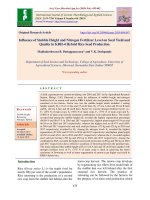
![Heterosis studies for seed yield and earliness in intra-specific hybrids of ricebean [Vigna umbellata (Thunb.) ohwi and ohashi] an under utilized pulse](https://media.store123doc.com/images/document/2020_01/09/medium_pxu1578554402.jpg)
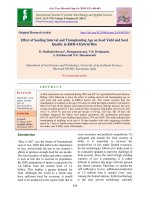

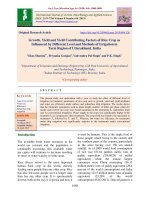


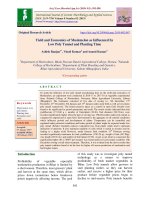
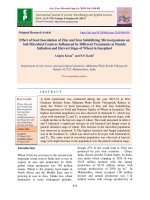
![Growth and yield of Ashwagandha [Withania somnifera (L.)] as influenced by different intercropping system in Kymore plateau of Madhya Pradesh](https://media.store123doc.com/images/document/2020_01/09/medium_vsb1578562778.jpg)